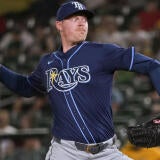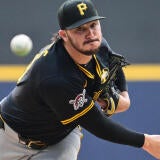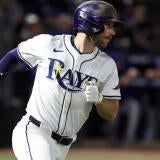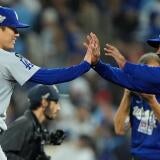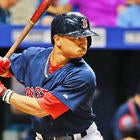Draft Day Dilemmas: Is it a gamble to take Mookie Betts?
Is Mookie Betts a safe option among a field of risky outfielders? Al Melchior argues that targeting the young Red Sox star is a more complicated proposition than some may think.

It's easy to see why Mookie Betts is a Fantasy darling heading into his third season with the Red Sox. He is only 23, fell just short of a 20/20 season in his first full year in the majors, scored 92 runs and hit .291. All that production helped Betts to finish as the 10th-ranked outfielder in Fantasy points and 15th in Rotisserie value.
Given Betts' achievements at such an early stage of his career, a top 10 finish in 2016 would seem like one of the safer assumptions to make as you rank your outfielders for Draft Day. Seem is the operative word here. While Betts' youth gives him the appearance of being on an inevitable upward trajectory, there are signs from his body of work that suggest we should put the brakes on our fervor.
The most troubling aspect of Betts' breakout season is that his total of 18 home runs looks suspect. Betts was among the worst hitters in terms of Isolated Power (Iso) and weighted on-base average (wOBA) on balls hit to the opposite field. These are not leaderboards that Betts should be anxious to appear on. Of the 20 qualifying hitters who had an Iso below .060 on balls to the opposite field, Betts was one of only five to finish with more than a dozen home runs. Kyle Seager, Yangervis Solarte, Wilmer Flores and Jimmy Rollins were the others, and out of this group, only Seager is remotely close to being an upper echelon player. The performance was also an outllier for Seager, and he is more prone to pulling flyballs than Betts.
Betts has had issues with opposite field power in both of his major league seasons. Going back to 2012, only six qualifying players -- Jamey Carroll, Ichiro Suzuki, Alberto Callaspo, Ruben Tejada, Placido Polanco and Ryan Theriot -- have a lower opposite field Iso than Betts, and only Brian Dozier has a lower opposite field wOBA. If the inclusion of the power-hitting Dozier here gives you hope for Betts, keep in mind that the Twins' second baseman is an extreme pull hitter, so his work to the opposite field is less relevant. Dozier's pull hitting has also decimated his batting average.
Batting average is something Betts hasn't had to worry about so far. He doesn't strike out much, pulls the ball at a near-average rate and gets his share of infield hits. However, Betts has a career .328 batting average on grounders, which is just slightly below Dee Gordon's mark for the last two seasons, making his average look hard to sustain. There isn't much batting average upside left to be had by Betts, unless he whittles down an already-low strikeout rate or drives the ball further. The former is plausible, while the latter looks far more dubious. To even maintain an overall batting average in the .290s, Betts may need to do at least one of these things, because he could have trouble getting as many hits on grounders as he has to date.
One trend could give us reason to expect Betts to sustain his 2015 numbers, yet at the same time, make him dubious as an early-round pick. Fenway Park is a great place to get doubles and hits on balls in play in general, in part due to the Green Monster, and Betts has apparently benefited from that. Of his 54 career doubles, 34 have come at home, and he has a .335 BABIP at Fenway as opposed to a .292 mark elsewhere. Over his young career, Betts has a healthy .864 OPS at home and a .774 OPS on the road. If the trend persists, Betts will be a must-start world beater in weeks where he plays all home games, but someone you might sit in a three-outfielder league if he is on a road trip.
None of this is to say that Betts is destined to regress in 2016. It is only to point out that maintaining or improving upon 2015 is far from inevitable. Beyond the top seven options at outfield, you are choosing among players with significant risk, and some of Betts' popularity may have to do with the perception that he's the "safe" low-end No. 1 outfielder. He certainly has as much upside as other top outfielders, as his minor league numbers indicate. Betts just may not deserve the "safety" tag any more than George Springer, Starling Marte, Nelson Cruz or Ryan Braun.



